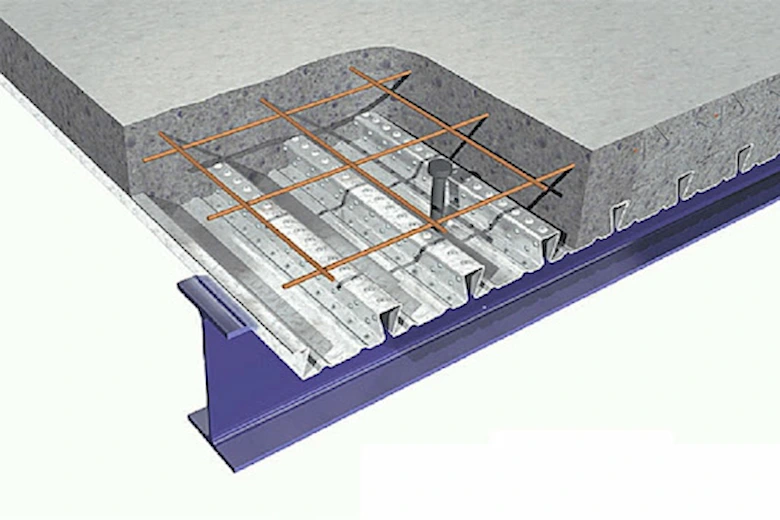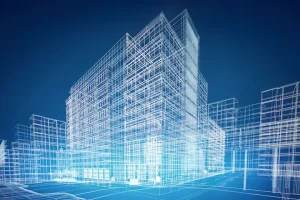Today, the construction industry has moved towards the use of modern and efficient systems. SRC (Steel Reinforced Concrete) and LSF (Light Steel Frame) structures, as two advanced technologies in this field, each have their own advantages and applications. The choice between these two types of structures has a significant impact on the cost, implementation time, and final quality of the project. Understanding the differences, advantages, and disadvantages of these systems can help architects, engineers, and investors make the best decision for their specific project needs. Today, in this article, we are going to fully introduce the SRC structure and compare it with the LSF structure. Follow us until the end.
What is SRC structure?
SRC (Steel Reinforced Concrete) structures are a combination of reinforced concrete and steel that are used in the design of structures to increase strength and reduce weight. In these structures, the steel core is placed inside the concrete section, and this combination creates a structure with high resistance to compressive and tensile forces. Steel, due to its flexibility and high tensile strength, performs better against deformations and earthquake stresses, while concrete with high compressive strength supports this steel against compressive forces. One of the outstanding features of this type of structure is its excellent performance in dealing with earthquakes, which has made it a suitable option for high-rise buildings.
SRC structures have high durability and reduced maintenance costs due to the combination of the properties of concrete and steel. These structures are widely used in construction projects such as towers, bridges, and underground structures. In addition, the implementation of this structural system allows for the reduction of the thickness of walls and columns, which increases the useful internal space. Another advantage is its fire resistance, since the concrete acts as a thermal insulator and prevents the steel from being damaged at high temperatures. As a result, SRC structures are ideal for projects that require a combination of strength, stability, and durability.


Advantages of SRC structure
1. High resistance to compressive and tensile forces
SRC structures offer a combination of high resistance to compressive and tensile forces due to the simultaneous use of steel and concrete. Concrete alone has excellent resistance to compression, but is weak against tension. In contrast, steel has high tensile strength. The combination of these two materials makes SRC structures perform very well against a variety of dynamic and static loads. This feature is especially important in areas with earthquake risk or severe weather conditions and ensures the safety of the structure.
2. Saving internal space of the structure
Due to the high strength of SRC structures, the dimensions of load-bearing columns and walls can be smaller than in all-concrete structures. This allows for more interior space for users and increases space efficiency. This feature is especially important in commercial and residential projects with limited space, as it allows for more functional and open designs.
3. Increasing the lifespan of the structure
The combination of steel and concrete in SRC structures increases durability and resistance to environmental factors such as moisture, corrosion, and temperature changes. The concrete protects the steel from rusting, and the steel prevents the concrete from cracking. This mutual cooperation allows the structure to remain functional for decades and reduces maintenance costs.
4. Excellent fire performance
SRC structures have high resistance to heat and fire. Concrete, as a non-combustible material, protects steel elements from thermal damage. This advantage helps reduce the risk of structural damage during a fire and provides more time for safe evacuation of the building. Therefore, this type of structure is a suitable option for large and public buildings.
5. Flexibility in design and architecture
The use of SRC structures allows architects and engineers to create more complex and diverse designs. The combination of concrete and steel reduces the usual design limitations of concrete structures. In addition, due to the possibility of using thinner columns, designers can easily design more open and unobstructed spaces, which is ideal for modern and creative projects.
6. Reducing construction and implementation costs
Although SRC structures may seem more expensive at first glance, in the long run they reduce overall construction and maintenance costs due to the reduced volume of materials used, high speed of construction, and reduced need for frequent repairs. Also, these types of structures require smaller and more economical foundations due to their lower weight compared to all-concrete structures, which is another cost-saving factor.
7. Favorable behavior against seismic loads
SRC structures perform very well against seismic loads due to their combined properties. Steel gives the structure flexibility and concrete absorbs earthquake energy. This combination reduces the likelihood of the structure collapsing during an earthquake and improves the safety of the occupants. This feature has made SRC structures a safe option for earthquake-prone areas.


Step by step implementation of SRC structure
1. Design and preparation of maps
The first step in implementing SRC structures is to accurately design structural and operational drawings. Structural engineers must design steel and concrete combination drawings based on geographical conditions, loading type, and project needs. This step includes calculating compressive, tensile, and shear loads to optimize the steel and concrete combination. Also, in this step, the required material specifications, section dimensions, and connection types are determined. Attention to detail in this step forms the foundation for the quality of the structure’s implementation.
2. Preparing the project site
After the drawings are drawn up, the project site must be prepared. This includes clearing the site, excavating, and preparing the foundation bed. The foundation must be designed and constructed in a way that it can withstand the weight of the structure and the forces acting on it. At this stage, it is very important to carefully examine the soil strength, provide proper drainage, and create a flat and solid bed. The location of the steel bars and profiles in the foundation is also determined.
3. Installation of reinforced steel (Steel Section)
At this stage, steel profiles (usually I-shaped or H-shaped) are installed as the main reinforcement part of the structure. These profiles must be cut according to the drawings and correctly positioned in their places. Steel connections must be made accurately using welding or bolts to ensure the integrity of the structure. Attention to weld strength and compliance with construction standards is very important at this stage, because steel plays a major role in bearing tensile and bending loads.
4. Installing concrete formwork
After the reinforcing steel is installed, the concrete formwork is installed. These formworks are usually made of wood, metal or plastic and must be designed to ensure the final shape of the concrete pour. At this stage, the formworks must be completely watertight to prevent concrete leakage. In addition, the formwork must be designed so that the concrete can be poured evenly around the steel profiles to create a good bond between the concrete and the steel.
5. Concrete pouring and vibration
Concrete pouring is one of the critical stages in the implementation of SRC structures. Concrete must be prepared with high quality and using precise proportions of materials (cement, water, sand and gravel). Concrete injection is done gradually and layer by layer to prevent the formation of air bubbles and voids. At this stage, vibration devices are used for better compaction of the concrete and its proper adhesion to the steel. Adhering to the exact timing for concrete pouring and curing plays an important role in the final quality of the structure.
6. Concrete Curing
After pouring, the concrete begins to cure to ensure its ultimate strength and durability. This process involves keeping the concrete moist and preventing it from drying out too quickly. This is usually done by covering the concrete with wet sacks or spraying it with water. The curing time varies depending on the environmental conditions and type of concrete, but typically takes at least 7 to 14 days. This step is critical to preventing cracking and increasing the durability of the structure.
7. Structural inspection and testing
After the concrete is poured and cured, the structure must be tested and inspected. This includes testing the compressive strength of the concrete, checking the quality of the steel connections, and non-destructive testing (NDT) to ensure the integrity of the structure. This step ensures that the structure has been designed and executed to standards and is ready to withstand real loads.
8. Final implementation and completion of the project
In the final stage, finishing work is carried out, including removing the forms, repairing the concrete details, and preparing the structure for other parts of the project. After this stage, the structure is ready for operation and other architectural and installation parts can be implemented on it.

Difference between SRC structure and LSF structure
1. Type of materials and main structure
SRC structures are a combination of concrete and steel, with steel being the main reinforcement within the concrete. This combination provides high resistance to compressive and tensile forces. In contrast, LSF structures are made of lightweight steel sections (usually 0.5 to 3 mm thick), which are lighter in weight without the need for concrete. This difference in materials makes SRC structures more suitable for heavy and large projects, and LSF structures for light and medium-sized projects.
2. Speed of implementation and project scheduling
LSF structures have a high speed of implementation due to the use of prefabricated profiles and modular systems. These types of structures are usually manufactured in a factory and transported to the project site, so the implementation time is greatly reduced. In contrast, the implementation of SRC structures is more time-consuming, because pouring concrete, forming and curing concrete require more time. This difference makes LSF structures a suitable option for projects with limited time.
3. Weight of the structure and the need for a foundation
One of the main differences between SRC and LSF structures is their weight. SRC structures are heavier due to the use of concrete and steel and require a stronger and larger foundation. On the other hand, LSF structures are very light and require shallow and economical foundations. This advantage of LSF structures makes them ideal for projects in areas with weak soil or low bearing capacity.
4. Earthquake resistance
LSF structures have excellent performance against seismic loads due to their light weight and high flexibility. The lower weight reduces the earthquake force on the structure, and the flexibility of the light steel prevents the structure from failing. In contrast, SRC structures also have excellent resistance to earthquakes, but their higher weight can introduce more seismic forces to the structure. Therefore, in earthquake-prone areas, LSF structures are a better choice.
5. Construction cost and economic efficiency
The cost of constructing SRC structures is higher due to the use of concrete, formwork, and longer construction time. In contrast, LSF structures are considered a more economical option due to their lower material consumption, faster construction speed, and reduced labor costs. This difference in cost makes LSF structures suitable for small to medium-sized residential and commercial projects, and SRC structures suitable for large infrastructure projects and high-rise buildings.

Is SRC structure better or LSF structure?
The choice between SRC and LSF structures depends on the type of project, environmental conditions and implementation needs. SRC structures, due to the combination of concrete and steel, have very high resistance to compressive and tensile forces and are suitable for heavy projects such as high-rise buildings, bridges and industrial structures. These types of structures have a longer life and perform better against environmental factors such as fire and corrosion. However, the high weight of these structures requires a stronger foundation and more time for implementation, which can increase construction costs.
In contrast, LSF structures are an ideal option for light and medium-sized projects such as residential, office and villa buildings due to their light weight, high implementation speed and low cost. These types of structures are very suitable, especially in earthquake-prone areas, due to their flexibility and reduction of seismic forces on the structure. However, LSF structures may be less durable against heavy loads and harsh environmental conditions. Therefore, it is not possible to say definitively which structure is better. The choice depends on the project needs and technical and economic priorities.
Final Words
As you can see, in this article, we have introduced and reviewed the SRC structure from 0 to 100 and provided a general comparison of this structure with the LSF structure. We have learned that both SRC and LSF structures are effective solutions for construction, but the choice between them depends entirely on the type of project and its needs. SRC structures with high strength and long durability are more suitable for heavy and complex projects, while LSF structures with high construction speed and lower cost are an ideal option for light and medium-sized buildings. Although both systems have their advantages and disadvantages, the combination of engineering knowledge and careful assessment of environmental and economic conditions can lead to correct decision-making and successful project implementation. Using this information, architects and engineers can design and implement a safe, economical and efficient structure. Dear friends, thank you for your support until the end of this article.
Ohaddeco Group specializes in the design and implementation of various KIT HOUSE using LSF structures and related internal coverings, including wooden acoustic wall covering and wooden thermowall. Dear friends, you can contact our experts for free consultation and more information through communication bridges.




